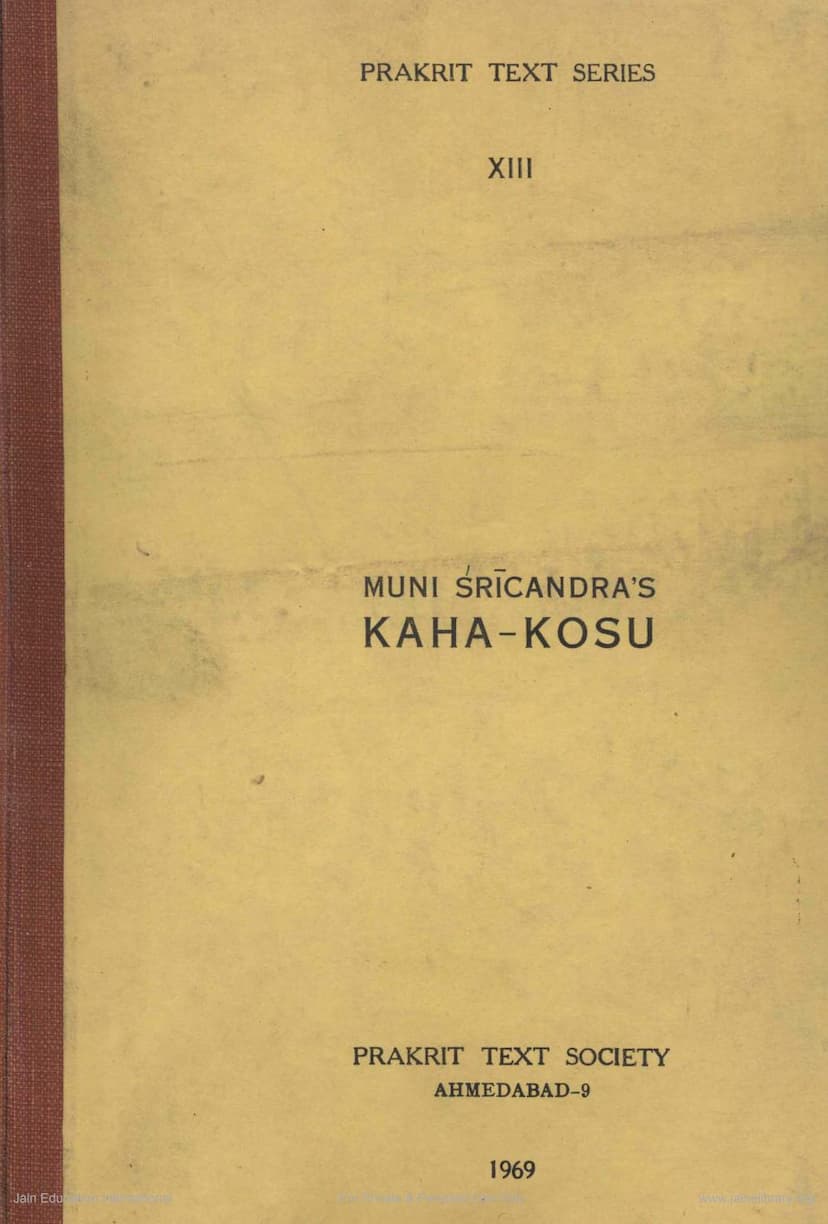Kahakosu
Added to library: September 2, 2025

Summary
Here's a comprehensive summary of the Jain text "Kahakosu" by Muni Shreechandra, based on the provided information:
Title: Kahakosu (also referred to as Kathakosa) Author: Muni Shreechandra Publisher: Prakrit Text Society, Ahmedabad Year of Publication: 1969 Language: Apabhramsa Century of Composition: Likely 11th Century (as indicated by editor's notes, though MS is later).
Overview:
"Kahakosu" is a significant Apabhramsa text containing a collection of Jain religious and moral stories. Muni Shreechandra, a Jain monk, composed this work, drawing inspiration and narrative material from earlier works, particularly Hariṣena's Sanskrit Kathākośa and potentially commentaries on the Bhagavati Ārādhana (Mūlārādhanā). The text aims to illustrate Jain principles and teachings through captivating narratives.
Key Aspects:
-
Manuscript and Editing:
- The text is edited for the first time by Dr. Hiralal Jain from a single, albeit dilapidated, manuscript discovered in the Shravak Sanghan of Karanja (Akola district, Maharashtra).
- The manuscript, written in Devanagari script, is on paper, dating back to Samvat 1783 (A.D. 1726). It is in a fragile condition, with ink absorption and breakage in many places, necessitating repair.
- The editor, Dr. H.L. Jain, faced the challenge of editing from a single manuscript but utilized his extensive experience with Apabhramsa works to provide a valuable edition for students of Jain literature and folklore.
-
Author and His Lineage:
- Muni Shreechandra was a monk belonging to the Kundakundanvaya, Balātkāragana, Sarasvatigaccha, and Mūlasangha.
- His monastic ancestry includes prominent figures like Śrīkirti, Śrutakirti, and Sahasrakīrti, who were contemporaries of influential rulers like Mularāja of Gujarat, Gangeya Deva (Kalachuri dynasty), and Bhojadeva (Paramāra dynasty).
- The text suggests Shreechandra may have been a contemporary of King Karna of Gujarat (son of Bhima I), as his work "Darśana-kathā-ratna-karandaka" (Dkrk) was completed during his reign in Samvat 1123 (A.D. 1066).
- Shreechandra likely became a monk after completing a significant portion of his "Darśana-kathā-ratna-karandaka," as the Kahakosu refers to him as a "Muni" from the outset.
-
Socio-Historical Context:
- The text provides insights into the socio-historical context of Jainism during the period, mentioning the Prāgvāta family's prominence in Gujarat and their connections with cities like Anahillapura (Patan) and Śrīmāla (Bhinmal).
- It highlights the intertwined relationship between monastic lineages and influential lay patrons, often from merchant communities.
- The text also touches upon the coexistence and occasional intermingling of Śvetāmbara and Digambara sects within the same families, indicating a degree of tolerance.
-
Content and Structure:
- The Kahakosu is a substantial work, comprising 53 saṁdhis (chapters) and a total of 1025 kaḍavakas (poetic units).
- The number of kaḍavakas varies significantly, from 10 to 32 per saṁdhi.
- The narrative structure often involves sandhi divisions that don't always align with the completion of a story, sometimes bisecting tales.
- Shreechandra begins by reflecting on the impermanence of worldly life and modestly states his limitations in knowledge but highlights his deep devotion to religion as the motivation for undertaking the composition.
- He announces the traditional lineage of the Kathākośa, tracing it from Lord Mahāvīra to the Ganadharas, then to King Śreṇika, Muni Śivakoti, and finally to himself.
-
Source Material and Influence:
- Shreechandra's Kahakosu is largely based on Hariṣena's Sanskrit Kathākośa (composed around A.D. 931-932). There is a remarkable agreement in the sequence of stories, basic content, and even shared vocabulary between the two works. Shreechandra's versions often appear as summaries of Hariṣena's more detailed accounts.
- Shreechandra deviates from Hariṣena by omitting certain stories (like Yaśodhara's, which he deems too well-known) and sometimes providing his own interpretations or summaries.
- The text also seems to have utilized additional sources, possibly commentaries on the Bhagavatī Ārādhana, as evidenced by his illustration of concepts like uddhyotana (both worldly and transcendental) found in Gāthā No. 2 of the Mūlārādhanā, which Hariṣena bypasses.
-
Illustrative Stories and Jain Principles:
- The Kahakosu illustrates various Jain principles, including:
- Right Faith (samyag-darśana) and its transgressions: Stories detail transgressions like doubt (śankā), desire for worldly objects (kāṅkṣā), displeasure with Jain teachings (vicikitsā), praise of heterodox views (paradṛṣṭipraśansa), and association with non-Jaina places of worship (anāyatana-sevā).
- Virtuous conduct and its consequences: The text emphasizes the importance of virtues like generosity (dāna), austerity (tapas), knowledge (jñāna), faith (śraddhā), and righteousness (dharma).
- The perils of worldly attachments and negative traits: Stories highlight the destructive nature of anger (krodha), ego (māna), greed (lobha), delusion (māyā), and sensual pleasures (kāma).
- The power of devotion (bhakti) and perseverance: The narratives underscore how devotion to Jina, the Tirthankaras, and adherence to Jain practices lead to liberation and spiritual progress.
- The importance of righteous actions and their karmic results: Many stories illustrate how actions, both good and bad, have consequences, shaping one's rebirth and spiritual journey.
- The Kahakosu illustrates various Jain principles, including:
-
Linguistic Features:
- The text is written in Apabhramsa, characterized by a mix of meters and interspersed quotations in Sanskrit and Prakrit.
- A significant point of discussion by the editor, Dr. H.L. Jain, is the use of dental 'n' (n) and cerebral 'ṇ' (ṇ) in the Apabhramsa text. The manuscript follows the Western Indian orthographical tradition, largely adhering to Hemacandra's Prakrit Grammar, which allows for optional retention of initial 'n'. The editor discusses the complexities and irregularities of this usage in Apabhramsa literature, influenced by earlier languages and regional variations.
Significance:
"Muni Śrīcandra's Kahakosu" is a valuable contribution to Apabhramsa literature, offering a rich collection of narratives that illuminate Jain philosophy and ethics. It provides a crucial Apabhramsa parallel to Hariṣena's Sanskrit Kathākośa, aiding in comparative studies of Jain narrative traditions and the evolution of Prakrit and Apabhramsa languages. The editor's meticulous work in bringing this single, fragile manuscript to light has preserved an important piece of cultural and religious heritage.